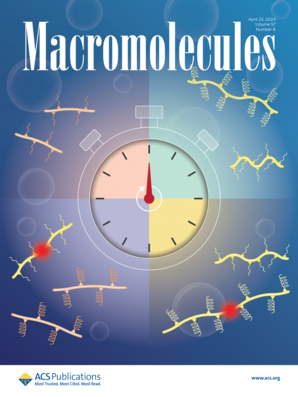Poly(cyclooctadiene-co-Ionic Liquid) Networks Cross-Linked via POSS–POSS Interactions
IF 5.2
1区 化学
Q1 POLYMER SCIENCE
引用次数: 0
Abstract
Organic–inorganic terpolymers comprising cyclooctadiene, ionic liquid, and polyhedral oligomeric silsesquioxanes (POSS) were synthesized through ring-opening metathesis polymerization, the POSS cages serving as the structural units of main chains. The self-assembled morphologies were created in the organic–inorganic terpolymers; the POSS cages were aggregated into microdomains of 20–30 nm. The generation of POSS microdomains led to the physical cross-linking with the POSS microdomains as the netpoints. The physical cross-linking was robust and thermally stable, endowing the terpolymers with improved mechanical strengths. Furthermore, the terpolymers displayed excellent self-adaptivity against stretching; the elongation at break can be as high as εb = 952.7%. In the meantime, the physical cross-linking endowed the terpolymers with shape memory properties. Benefiting from the intense exchange of ionic bonds, the organic–inorganic terpolymers were self-healable (or reprocessable). Also, the exchange of ionic bonds imparted reconfigurability to the shape memory terpolymers. With the ionic liquid moieties as the charge carriers, the organic–inorganic terpolymers can serve as the solid polyelectrolytes, and the ionic conductivity of which can be as high as 1.52 × 10–5 S × cm–1 at 300 K.

聚(环二烯-共离子液体)网络通过POSS-POSS相互作用交联
以POSS笼为主链结构单元,采用开环复聚法制备了由环二烯、离子液体和多面体低聚硅氧烷(POSS)组成的有机-无机三聚体。在有机-无机三聚体中产生了自组装形态;POSS笼聚集成20 ~ 30 nm的微畴。POSS微畴的生成导致了以POSS微畴为网络点的物理交联。物理交联牢固且热稳定,使三元共聚物具有更高的机械强度。此外,三元共聚物表现出良好的抗拉伸自适应性;断裂伸长率高达εb = 952.7%。同时,物理交联使三元共聚物具有形状记忆性能。得益于离子键的强烈交换,有机-无机三聚体具有自愈性(或可再加工性)。此外,离子键的交换使形状记忆三元聚合物具有可重构性。以离子液体部分为载流子,有机-无机三元聚合物可作为固体聚电解质,在300 K时离子电导率可高达1.52 × 10-5 S × cm-1。
本文章由计算机程序翻译,如有差异,请以英文原文为准。
求助全文
约1分钟内获得全文
求助全文
来源期刊

Macromolecules
工程技术-高分子科学
CiteScore
9.30
自引率
16.40%
发文量
942
审稿时长
2 months
期刊介绍:
Macromolecules publishes original, fundamental, and impactful research on all aspects of polymer science. Topics of interest include synthesis (e.g., controlled polymerizations, polymerization catalysis, post polymerization modification, new monomer structures and polymer architectures, and polymerization mechanisms/kinetics analysis); phase behavior, thermodynamics, dynamic, and ordering/disordering phenomena (e.g., self-assembly, gelation, crystallization, solution/melt/solid-state characteristics); structure and properties (e.g., mechanical and rheological properties, surface/interfacial characteristics, electronic and transport properties); new state of the art characterization (e.g., spectroscopy, scattering, microscopy, rheology), simulation (e.g., Monte Carlo, molecular dynamics, multi-scale/coarse-grained modeling), and theoretical methods. Renewable/sustainable polymers, polymer networks, responsive polymers, electro-, magneto- and opto-active macromolecules, inorganic polymers, charge-transporting polymers (ion-containing, semiconducting, and conducting), nanostructured polymers, and polymer composites are also of interest. Typical papers published in Macromolecules showcase important and innovative concepts, experimental methods/observations, and theoretical/computational approaches that demonstrate a fundamental advance in the understanding of polymers.
 求助内容:
求助内容: 应助结果提醒方式:
应助结果提醒方式:


